
Appalachian National Scenic Trail
©EWY Media/Shutterstock.com
Maine is an outdoor lover’s paradise and home to some of the most beautiful and demanding outdoor areas in the nation. One of the most challenging outdoor activities in Maine is taking a hike through the 100-mile wilderness section of the famous Appalachian Trail. Hiking, fishing, rock climbing, and all types of outdoor activities are available in Maine.
One of the things that make Maine even more attractive to snake-phobic outdoor enthusiasts is that it doesn’t have very many types of snakes — and none of them are venomous. Currently, Maine only has 9 types of snakes. Let’s dive into all nine of Maine’s snakes so you can identify them when in the Pine Tree State!
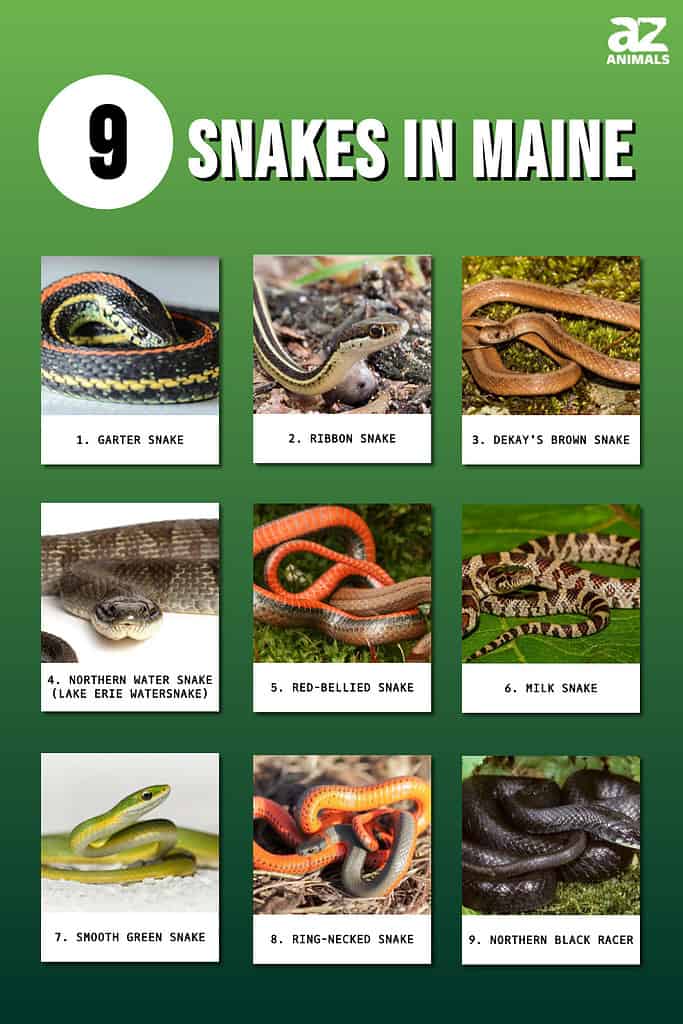
The 9 Snakes In Maine
While many states are home to dozens of snakes, Maine is home to less than 10. More importantly, it’s one of just three states that lack venomous snakes at all!
1. Garter Snake
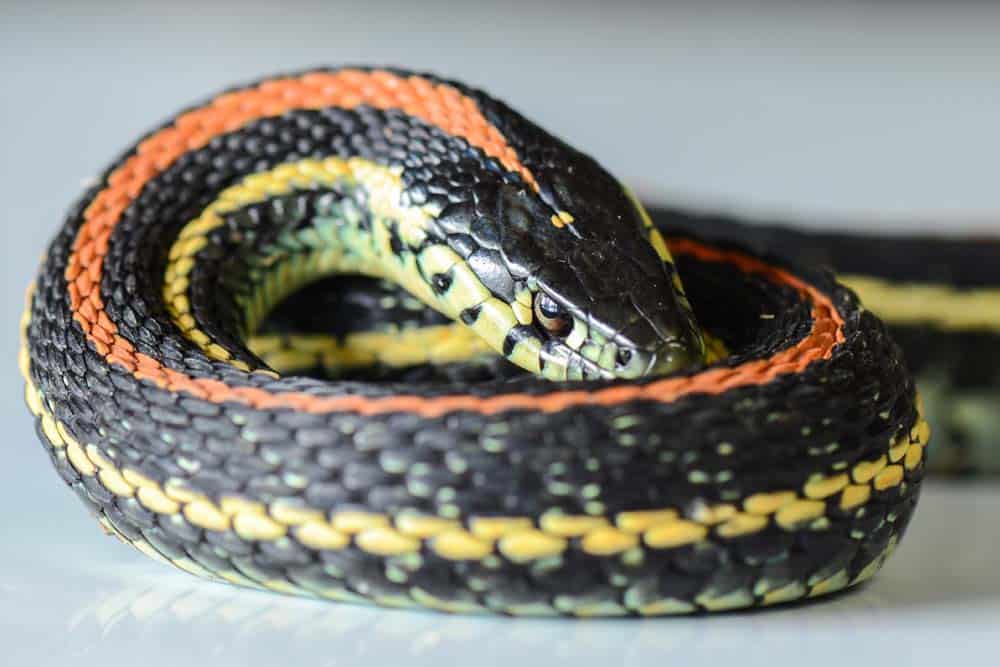
Garter snakes can usually be found near water.
©Lost Mountain Studio/Shutterstock.com
Garter snakes are common in Maine and many other states. These small, thin snakes are harmless to people. Although they will strike if they feel very threatened, they’re more likely to release a horrible-smelling musk and flee. Garter snakes are relatively small and rarely grow longer than 48 inches in any of their range, but even smaller in Maine.
These snakes often sun themselves on rocks during the day. They’re usually found in woods and near water. Garter snakes can have many different colors and marking patterns but they are usually some variation of yellow, brown, black, dark green. They may also have red markings.
There are 13 subspecies of garter snakes spread across North America, but the most common one in Maine is the maritime garter snake, which ranges across northeastern New England, Quebec, and the Maritime provinces of Canada. While other snakes have a more limited range in Maine, garter snakes are found throughout the state. Garter snakes eat mostly small invertebrates like frogs, insects, and small lizards.
2. Ribbon Snake

Ribbon snakes are small and harmless to humans.
©Steve Bower/Shutterstock.com
Ribbon snakes are harmless to humans. They prefer a semi-aquatic environment so most of the time they can be found living around the edges of lakes and rivers. Maine has lots of lakes and rivers where ribbon snakes can find residence. However, they most commonly inhabit the southwestern portion of the state near cities like Augusta and Portland. They’re not found inland or east beyond Bangor.
Ribbon snakes usually have a body that is dark green, brown, or black with light green or yellow markings that are similar to the markings that a garter snake has. There are several different varieties of ribbon snakes but all are non-threatening to humans so if you find one when you’re hiking or boating don’t worry. The ribbon snake will be totally uninterested in you in almost every case.
3. DeKay’s Brown Snake

Brown snakes
in Maine are not a threat to humans and rarely grow more than 14 inches in length.
©Jay Ondreicka/Shutterstock.com
Dekay’s brown snakes are woodland snakes that prefer a forest-type habitat. As their name suggests they are usually brown but they can also be dark green or black. Typically their bellies are light brown or yellow. Brown snakes have a very distinctive set of black dots on their faces. Those dots are the best way to identify a brown snake. Brown snakes are not intimidated by humans so they are not likely to flee if you see one. But they also are not aggressive at all so they’re not threatening to people. Like other snakes in Maine, they’re not typically found ar inland but will inhabit within 50 miles of the coastline from the border of Massachusetts to near Ellsworth.
4. Northern Water Snake (Lake Erie Watersnake)
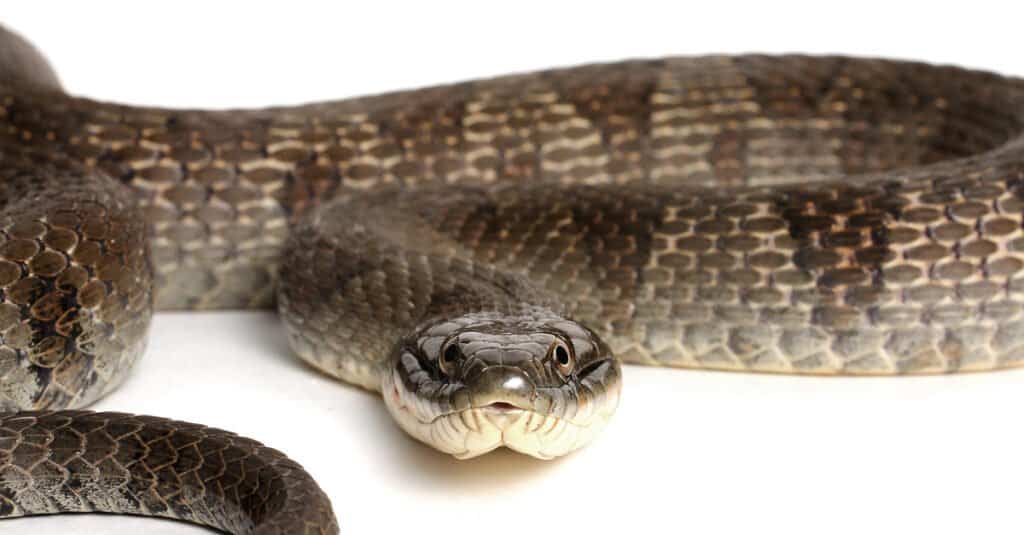
Northern water snakes are some of the largest snakes in Maine but are non-venomous.
©Michiel de Wit/Shutterstock.com
The northern water snake can look very scary. It’s a large snake that can grow over 60 inches long and they are usually black or dark gray with black or brown spots. As the name suggests it’s a snake that lives in and around water so if you are swimming or fishing or boating and you see a large black snake in the water or just on the shore you might get scared. But even though the northern water snake looks scary it’s actually not a threat to people at all. This snake doesn’t bother humans and prefers to be left alone to feed on fish and water creatures. They will sometimes sun themselves on rocks near the shore when the weather is quite warm.
Northern water snakes are the one kind of water snake in Maine and will breed during the spring and give birth during the fall. Their range is mostly confined to the southwestern quadrant of the state.
5. Red-Bellied Snake
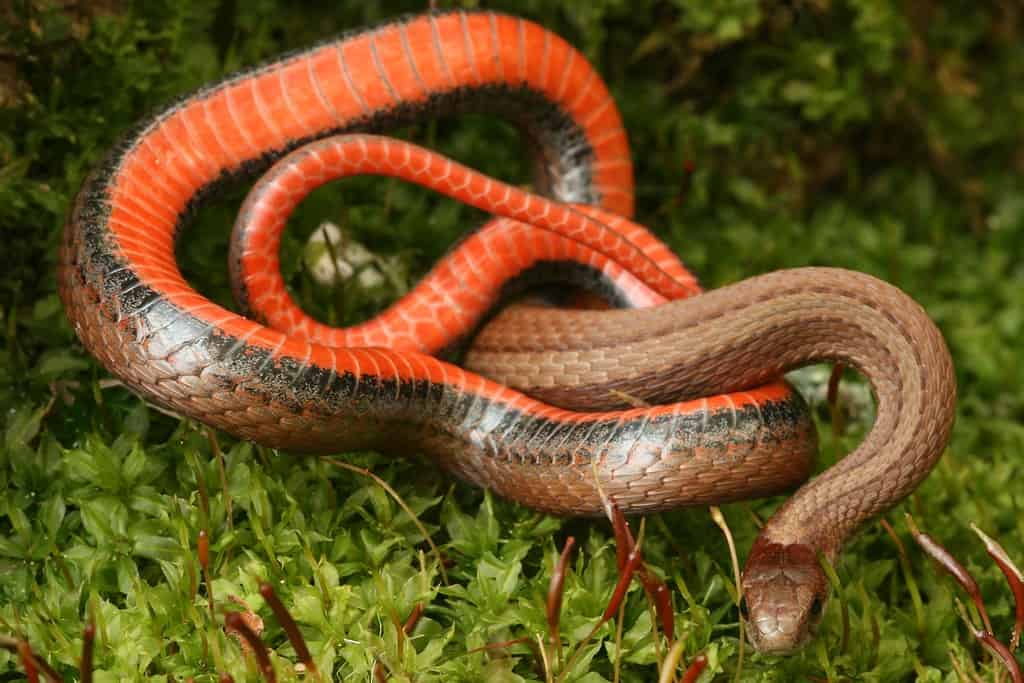
Red-bellied snakes are cousins to Dekay’s brownsnakes.
©Kevin Collison/Shutterstock.com
You can recognize a red-bellied snake by the distinctive red-orange color on the underside of the snake and the deep brown scales on the top of the snake. These snakes are usually fairly small and don’t grow much past a foot in length. Red-Bellied snakes are woodland dwellers who stay in the forests and heavily wooded areas that make up a huge portion of the state. Red-Bellied snakes pose no threat to humans at all. They eat insects primarily and move silently throughout the forest. If you like to hike or spend a lot of time in the forest you will probably see these snakes often but there’s no reason to be alarmed by them.
6. Eastern Milk Snake
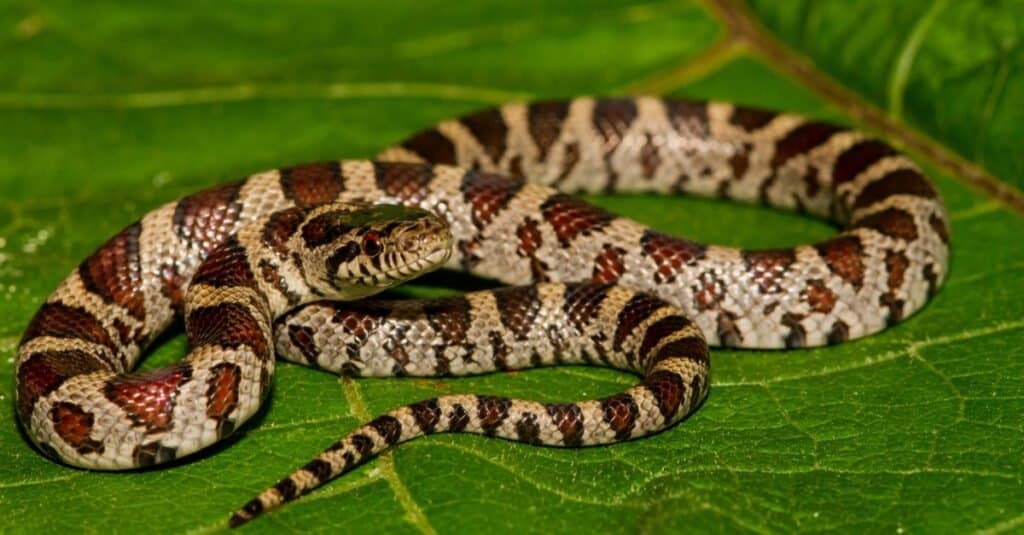
Eastern milk snakes are very beneficial animals, especially for farmers, as they hunt down small rodents often found on farm buildings and barns.
©Jay Ondreicka/Shutterstock.com
Eastern milk snakes are hard to miss. They have alternating bands of brown and tan blotches that can often appear quite red. In addition, they can grow up to 3 feet in length. But don’t be afraid of Milk Snakes. They are absolutely no threat to humans. Milk Snakes are often kept as pets because they are easy to handle. They’re also popular pets because they are docile and easygoing, and because of their beautiful colors and markings. In the wild, they prefer to live in mountainous areas or in pastures, meadows, and open areas.
7. Smooth Green Snake
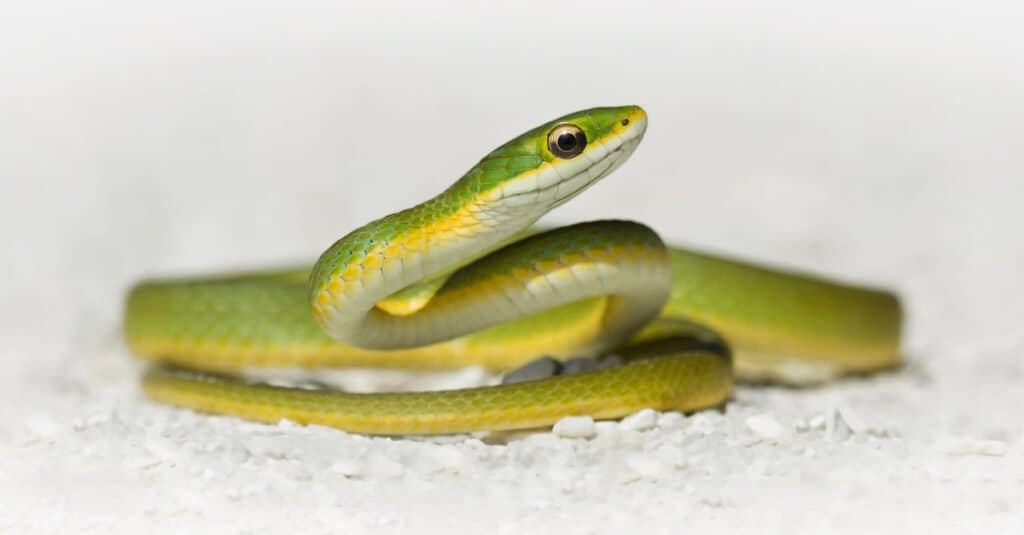
Smooth green snakes are difficult to spot but are found across the northeast and the maritime provinces
©Kristian Bell/Shutterstock.com
Even if you are a dedicated outdoor enthusiast you may go for years without ever seeing a Smooth Green Snake. Smooth Green Snakes are known for their glassy bright green scales. But they blend in so well with grass and plants that they are extremely difficult to spot. Green snakes are very small. Typically they don’t get larger than about 20 inches long. Smooth Green snakes are docile but prefer to hide from humans. A Smooth Green snake will go underground or hide deeply in brush and greenery so that it can’t be seen. These snakes are popular pets because they are easy keepers and eat insects.
8. Ring-Necked Snake

Small and colorful, the ring-necked snake is nocturnal and non-venomous.
©yhelfman/Shutterstock.com
The distinctive rings of yellow and orange all along the body of this snake give it the name the ring-necked snake. But these woodland and forest-dwelling snakes are shy and prefer to stay hidden. So, you may not even see the ring-necked snake even if one is quite near you. They are often just 12 inches long but may grow up to 16 inches long. The Ring-Necked Snake will bite sometimes if it feels like it’s cornered. But it usually will just disappear or hide as soon as humans enter the area it lives in.
9. Northern Black Racer

The black racer is an agile and very fast animal that can slither 4 miles per hour when it is threatened, hence the name “racer”.
©Breck P. Kent/Shutterstock.com
The northern black racer is a big black snake that can grow over 60 inches long. Black Racers are known for the speed of their attack. They also move very quickly when they are fleeing. The northern lack racer generally prefers to live in open grasslands or in the forest adjacent to open grasslands. Farmers and those who live in rural areas near large open fields may come across racers. Even though this snake is incredibly fast and big enough to consume small mammals it won’t hurt humans. So there’s no reason to be afraid of this snake.
Like other snakes in Maine, the species is largely only found in the southwestern quadrant of the state.
Venomous Snakes In Maine
Maine is one of only three states in the United States that has no venomous snakes. Hawaii and Alaska are the others. Any snake can strike out or bite if it feels like you’re a threat or if it feels like it’s being cornered. But there are no dangerous snakes in Maine. Most snakes would prefer to flee rather than attack. They would only strike out if they were surprised or really felt threatened. So it’s pretty easy to avoid any kind of snake bites when you’re in Maine.
Enjoy Snakes With No Risk
Since Maine is one of only three states with no venomous snakes you can observe snakes safely. It’s the only mainland U.S. state with no venomous snakes. So, it’s the best place to go if you want to observe snakes in the wild safely.
Summary Of The 9 Snakes In Maine
| # | Snake | Venomous or Non-Venomous? |
|---|---|---|
| 1 | Garter Snake | Non-Venomous |
| 2 | Ribbon Snake | Non-Venomous |
| 3 | DeKay’s Snake | Non-Venomous |
| 4 | Northern Water Snake (Lake Erie Watersnake) | Non-Venomous |
| 5 | Red-Bellied Snake | Non-Venomous |
| 6 | Milk Snake | Non-Venomous |
| 7 | Smooth Green Snake | Non-Venomous |
| 8 | Ring-necked Snake | Non-Venomous |
| 9 | Northern Black Racer Snake | Non-Venomous |
Other Dangerous Animals Found In Maine
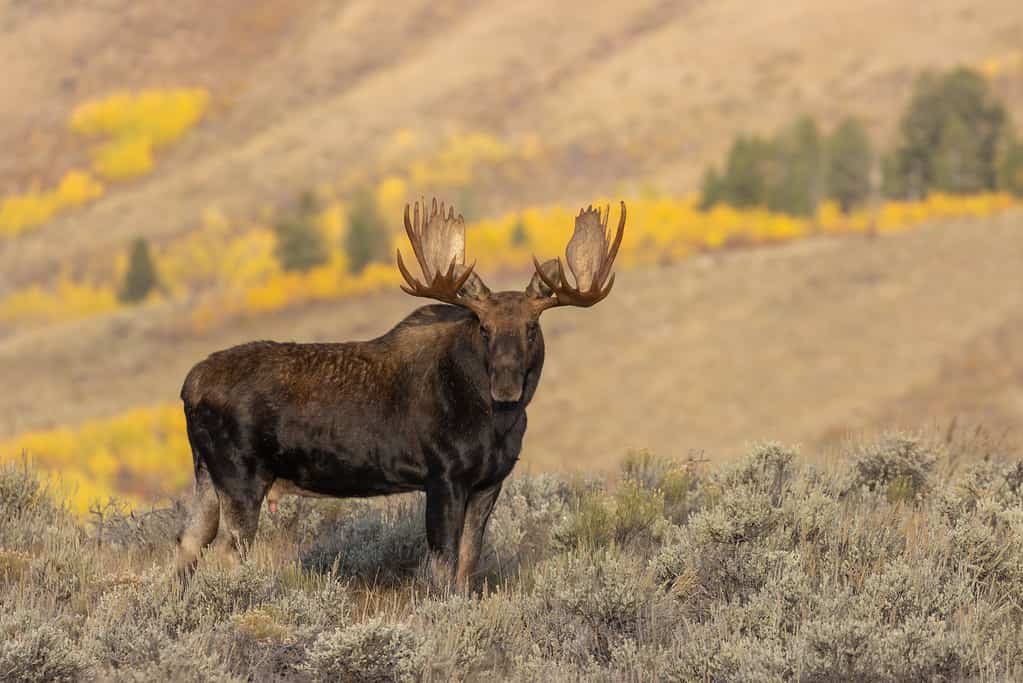
With average speeds of up to 35 miles per hour, the Moose is rather speedy.
©Tom Tietz/Shutterstock.com
The largest and heaviest member of the deer family is the moose, which is found throughout Maine and has one of the largest populations located in this state. They generally leave humans alone and are not aggressive towards them but are rather aggressive towards each other, however, if you encounter this large mammal, especially during mating season, you will need to proceed with caution, back away slowly, and should always leave them alone. Moose can run relatively fast, at up to speeds of 35 miles per hour, so running away is not wise, but maintaining distance is always the smartest option.
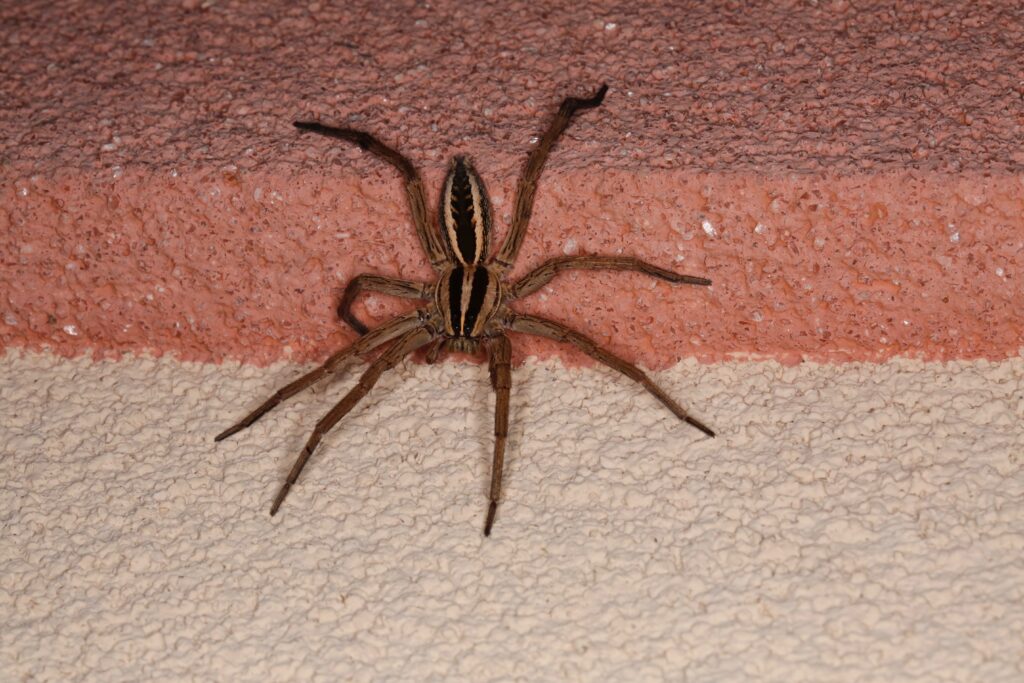
Wolf spiders are highly adept hunters.
©Cathleen Wake Gorbatenko/Shutterstock.com
The very large wolf spider can grow to the size of 1.5 inches and prefers to hunt. This arachnid is quite often mistaken for a brown recluse but unlike the recluse, which is only brown, the wolf spider is brown and black with stripes running down their bodies and even though they can be fairly aggressive, they do not pose a threat to humans. Like all spiders, they do bite, and they may leave fang-like marks on your skin although they are not venomous, and you may still experience symptoms of itching, redness, and swelling.
Bonus: Which U.S. State Has the Most Snake Bites?
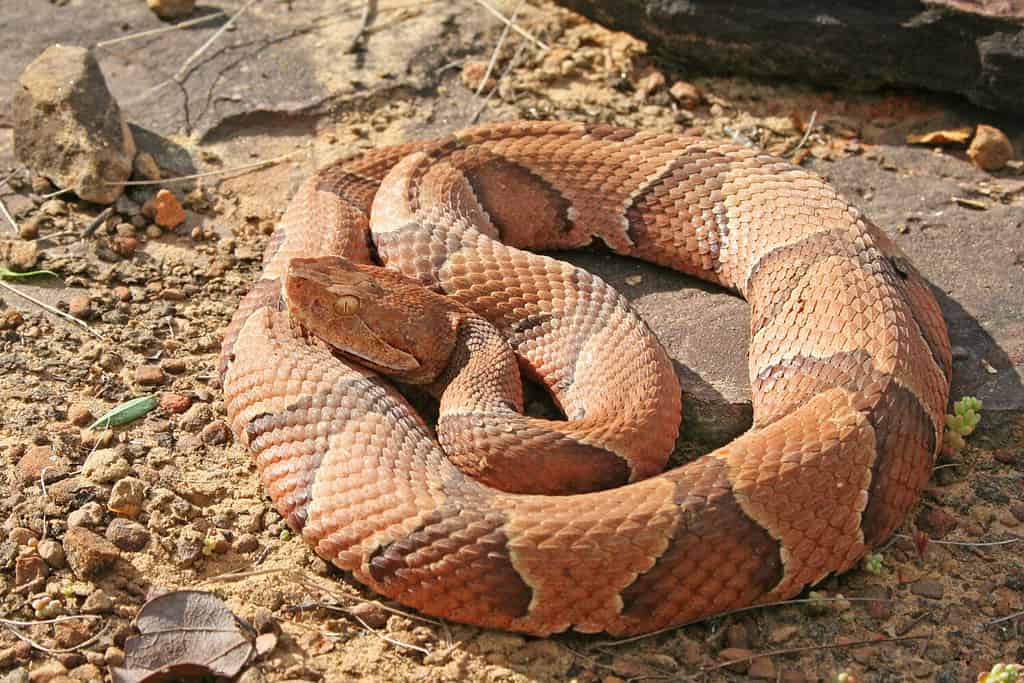
The venomous copperhead snake is among those responsible for snake bites in North Carolina.
©Creeping Things/Shutterstock.com
As you’ve already discovered, there are no venomous snakes in Maine. As far as snake bites across the nation go, most of those that are actually reported are those that come from venomous snakes, as they cause harm to humans. It’s hard to find data on how many snake bites occur annually in Maine, and that’s probably due to the fact that the bites come from harmless nonvenomous snakes.
However, there are other U.S. states where numerous snake bites are taking place each year. So which state ranks the highest in snake bites? That would be North Carolina. The snake bite rate in this southeastern state is 157.8 bites per million population annually. As the population as of 2021 was a little over 10 million (10.55 to be exact), and we were to just figure it off of 10 million, that would average out to roughly 1,580 reported snake bites per year.
The top 6 states for reported snake bites are:
| Rank | State | Bites per Million |
|---|---|---|
| 1 | North Carolina | 157.8 |
| 2 | West Virginia | 105.3 |
| 3 | Arkansas | 92.9 |
| 4 | Oklahoma | 61 |
| 5 | Virginia | 48.7 |
| 6 | Texas | 44.2 |
There are 6 different kinds of venomous snakes inhabiting North Carolina: copperhead, cottonmouth, eastern coral snake, eastern diamondback rattlesnake, pigmy rattlesnake, and timber rattlesnake. In the year 2019, there were 92 people bitten by venomous snakes in that state.
The photo featured at the top of this post is © Breck P. Kent/Shutterstock.com
Discover the "Monster" Snake 5X Bigger than an Anaconda
Every day A-Z Animals sends out some of the most incredible facts in the world from our free newsletter. Want to discover the 10 most beautiful snakes in the world, a "snake island" where you're never more than 3 feet from danger, or a "monster" snake 5X larger than an anaconda? Then sign up right now and you'll start receiving our daily newsletter absolutely free.
Thank you for reading! Have some feedback for us? Contact the AZ Animals editorial team.







